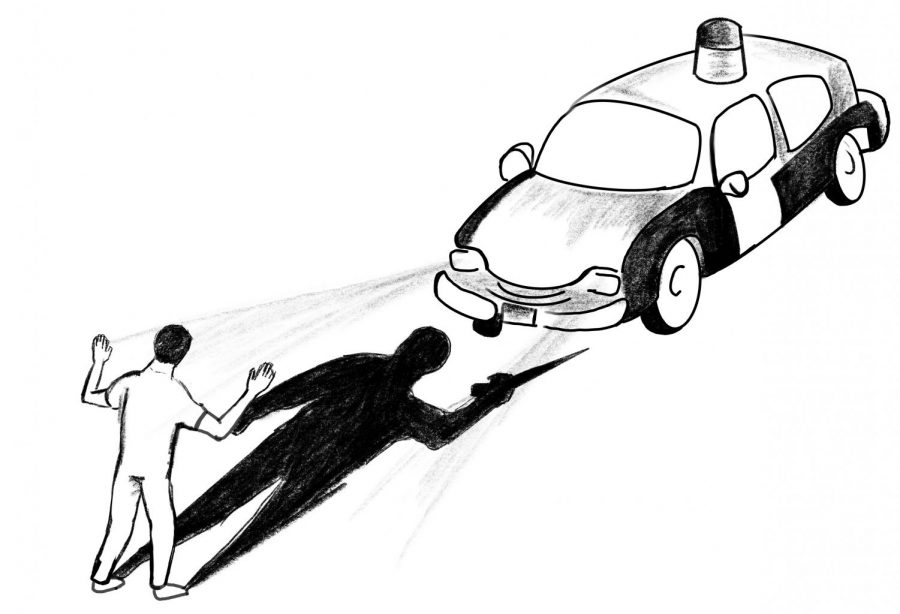Two days before New Year’s Day, 19-year-old Christian Hall stood on a highway overpass in Pennsylvania. He had contacted the police, hoping that they could offer him assistance in the middle of a mental health crisis. However, “objective reasonableness,” a subjective standard that allowed the police to determine whether he posed enough of a threat to justify deadly violence, won over. Pennsylvania State Police decided he did, even releasing a statement claiming that “Hall pointed [a] firearm in the Troopers direction. As a result, Troopers fired striking Hall.”
In the footage of his shooting released in early February, he crumpled with his hands in the air.
Two days before Christmas, Angelo Quinto, a Navy veteran who suffered from depression, was experiencing a mental health crisis when his sister called the police for assistance. When his mother began filming the situation (police officers switched off their body cameras), Quinto is lying face down on the floor.
“What happened,” his mother asks, “What happened?”
No one responds. Quinto died three days later, 65 miles northeast of the upper school campus. His family reported that officers knelt on his back for five minutes, similar to the killing of George Floyd last summer.
A statement from the Antioch Police Department promised “to provide the public with more information” “once some additional portions of the investigation are completed,” although the department waited a month to confirm his death, and only responded after requests from the East Bay Times.
Weeks of chilling silence passed before the deaths of these two men were acknowledged. In Quinto’s case, his killing was only acknowledged due to the family filing a claim against the Antioch Police Department. At a minimum, their stories should be known. They provide deadly examples of unreasonable uses of force in officer intervention.
The lack of coverage and extreme delay in reporting on their deaths expose the gaps in proper police responses to mental health. News articles about Hall quickly end before even two pages of search results, and all but one waited until footage of his shooting was released in February to report on his death. While the police immediately responded with a fatal show of force, the press barely murmured.
Their deaths came as a result of the failure to follow protocol and de-escalate the mental health episode. In 2018, 25% of the approximately 1,000 people fatally shot by police in the U.S. had mental illness. The Crisis Intervention Team (CIT), a structure in law enforcement designed to minimize accounts of injury or death in encounters between police and people with mental illness, failed to reduce the use of force. In 2015, American law enforcement agencies traveled to Scotland to investigate how the country’s officers respond to confrontations. Even in cases involving an armed individual, they responded through methods of crisis intervention rather than immediate force. Bringing in specially trained mental health response teams, requiring body cameras that are open at all times, and eliminating knee-to-neck restraints would center humanity at the forefront of law enforcement.
Establishing partnerships with mental health providers can inform law enforcement on the best practices for responding to mental illness, a condition not bound by age. In 2016, 7.7 million people in the U.S. aged 6 to 17 experienced a mental health disorder, negatively affecting academic performance and overall well-being. However, nearly 80% did not receive proper services, and the pandemic has only increased feelings of loneliness and anxiety. Such instances require responses from trained counselors and not armed officers.
Alternatives to requiring police officers to become trained experts on mental health curricula include diverting 911 police calls to crisis telephone lines staffed with medical professionals who provide guidance to the individual in crisis. Emergency Medical Services can also send Emergency Medical Technicians, counselors, and physicians to bring individuals to specialized facilities for mental health treatment.
Minimizing police response in cases of mental illness both reduces requirements for officers and lowers the chance of fatal uses of force, finally achieving what should be the goal of policing: safety and security.
If you are thinking about suicide or would like emotional support, contact the National Suicide Prevention Lifeline at 1-800-273-8255 or connect with a trained crisis counselor by texting HOME to 741741. If you are experiencing emotional distress, anxiety, or symptoms relating to depression in response to any disaster, contact the Disaster Distress Helpline at 1-800-985-5990.
This story was originally published on Harker Aquila on March 6, 2021.































![IN THE SPOTLIGHT: Junior Zalie Mann performs “I Love to Cry at Weddings,” an ensemble piece from the fall musical Sweet Charity, to prospective students during the Fine Arts Showcase on Wednesday, Nov. 8. The showcase is a compilation of performances and demonstrations from each fine arts strand offered at McCallum. This show is put on so that prospective students can see if they are interested in joining an academy or major.
Sweet Charity originally ran the weekends of Sept. 28 and Oct. 8, but made a comeback for the Fine Arts Showcase.
“[Being at the front in the spotlight] is my favorite part of the whole dance, so I was super happy to be on stage performing and smiling at the audience,” Mann said.
Mann performed in both the musical theatre performance and dance excerpt “Ethereal,” a contemporary piece choreographed by the new dance director Terrance Carson, in the showcase. With also being a dance ambassador, Mann got to talk about what MAC dance is, her experience and answer any questions the aspiring arts majors and their parents may have.
Caption by Maya Tackett.](https://bestofsno.com/wp-content/uploads/2024/02/53321803427_47cd17fe70_o-1-1200x800.jpg)
![SPREADING THE JOY: Sophomore Chim Becker poses with sophomores Cozbi Sims and Lou Davidson while manning a table at the Hispanic Heritage treat day during lunch of Sept 28. Becker is a part of the students of color alliance, who put together the activity to raise money for their club.
“It [the stand] was really fun because McCallum has a lot of latino kids,” Becker said. “And I think it was nice that I could share the stuff that I usually just have at home with people who have never tried it before.”
Becker recognizes the importance of celebrating Hispanic heritage at Mac.
“I think its important to celebrate,” Becker said. “Because our culture is awesome and super cool, and everybody should be able to learn about other cultures of the world.”
Caption by JoJo Barnard.](https://bestofsno.com/wp-content/uploads/2024/01/53221601352_4127a81c41_o-1200x675.jpg)






